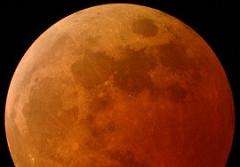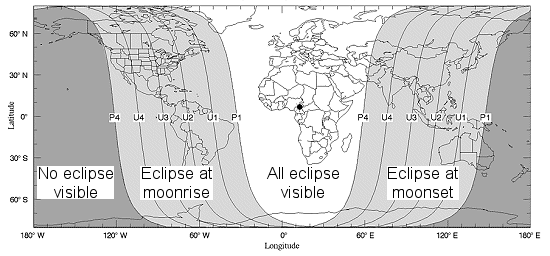Lunar Eclipse

Picture this: The year is 2025 and you're on the moon. "Home" is 100 meters away—an outpost on the rim of Shackleton Crater. NASA started building it five years earlier, and it is growing fast. You're one of the construction workers.
As always in these polar regions, the sun hangs low, barely above the craggy lunar horizon. You adjust your visor. It amazes you how bright a low sun can be when there's no atmosphere to dim it.
Suddenly, the lights go out.
Up in the sky, a big black disk covers the sun. A red "ring of fire" appears where the sun was only moments before, and its glow turns the ground red beneath your feet.
You've been waiting for this. It's an eclipse.
Astronauts on the moon are going to experience eclipses typically once or twice a year: Earth glides in front of the sun turning lunar day into a strange kind of ruddy night. It'll be one of the highlights of any lunar tour.

The charm of the eclipse comes from Earth. Our planet is big enough by a factor of three to block the entire sun but, curiously, this doesn't cause complete darkness. Rays of sunlight bend around the edge of Earth, filtering through the atmosphere. As seen from the moon, the edge of Earth lights up like a sunset-red ring of fire—one of the most beautiful sights in the solar system.
Can't wait until 2025? The next eclipse is right around the corner: Saturday, March 3, 2007. Stuck on Earth, we can't see the ring of fire, but we can see the red glow it produces on the moon. The phenomenon will be visible from parts of all seven continents including the eastern half of North America.
In the USA, the eclipse will already be underway when the moon rises on Saturday evening. Observing tip: Find a place with a clear view of the eastern horizon and station yourself there at sunset. As the sun goes down behind you, a red moon will rise before your eyes.
Rising moons are often reddened by clouds or pollution, but this moon will be the deep, extraordinary red only seen during a lunar eclipse. As you watch it ascend into the night, imagine what it would be like to stand by Shackleton Crater watching from the opposite direction.
It's not so far-fetched. NASA plans to return astronauts to the moon no later than 2020. From their polar base camp, humans will explore the countryside hunting for resources they can use to "live off the land." They'll study the moon's geology, learning more about the unique potential of the moon to reveal ancient secrets of Earth and the solar system. They'll also evaluate evaluate technologies needed for future missions to Mars.
And occasionally when the ground turns red, they'll pause and look up at a glowing ring in the sky.
March 3rd is a good night to imagine that.
Source: by Dr. Tony Phillips, Science@NASA





















